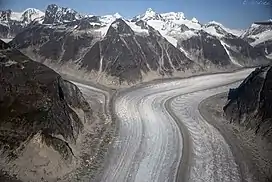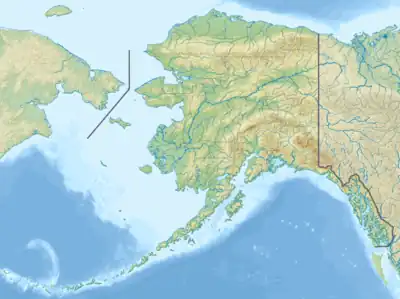| Mount Queena | |
|---|---|
 Mt. Queena (right of center) from southwest | |
| Highest point | |
| Elevation | 7,620+ ft (2,320+ m)[1] |
| Prominence | 2,320 ft (710 m)[1] |
| Parent peak | Mount Bressler[2] |
| Isolation | 2.93 mi (4.72 km)[1] |
| Coordinates | 58°51′46″N 134°20′24″W / 58.86278°N 134.34000°W[2] |
| Geography | |
 Mount Queena Location of Mount Queena in Alaska | |
| Location | Tongass National Forest Juneau Borough Alaska, United States |
| Parent range | Coast Mountains Boundary Ranges Juneau Icefield[1] |
| Topo map | USGS Juneau D-2 |
Mount Queena is a 7,620+ ft (2,320+ m) elevation mountain summit located in the Boundary Ranges of the Coast Mountains, in the U.S. state of Alaska. This unofficially named peak is situated on the Juneau Icefield, 39 mi (63 km) north of Juneau, 2.7 mi (4 km) west of the Canada–United States border, and 5 mi (8 km) northeast of Mount Blachnitzky, on land managed by Tongass National Forest. Although modest in elevation, relief is significant since the east aspect of the mountain rises over 3,200 feet above the Gilkey Glacier in less than one mile.
Climate
Based on the Köppen climate classification, Mount Queena has a subarctic climate with cold, snowy winters, and cool summers.[3] Most weather fronts originate in the Pacific Ocean, and travel east toward the Coast Mountains where they are forced upward by the range (Orographic lift), causing them to drop their moisture in the form of rain or snowfall. As a result, the Coast Mountains experience high precipitation, especially during the winter months in the form of snowfall. Temperatures can drop below −20 °C with wind chill factors below −30 °C. The months June and July offer the most favorable weather for viewing this rarely climbed peak.
See also
.jpg.webp)